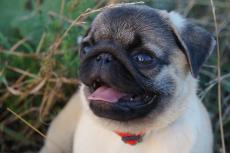Measuring the pug's baseline
De mopshond. Een uniek hondenras, behorend bij de brachycefale rassen, de kortsnuiten. En over die kortsnuiten is veel te doen. Om te zorgen dat de Mopshond blijft bestaan is het dus zaak te zorgen dat het ras voldoende gezond blijft om dat bestaan te rechtvaardigen.
The pug. A unique dog breed, one of the brachycephalic breeds, the short muzzled dogs. And there is a lot to do about those brachy dogs. In order to ensure that the Pug will be around it is important to ensure that the breed remains sufficiently healthy to justify its existence. The construction of a dog's head matters a lot when talking about the health of that dog.
A well-built head provides good breathing and thus also the regulation of the body temperature. After all, a dog cools its body by panting, but the air it cools down must be sufficient and the airways must be open and accessible.
In a dog with a short skull and muzzle, the nose content is smaller, the nostrils are smaller and therefore there is less possibility to inhale. Another brachy problem is the fact the structures in the throat are often underdeveloped, a problem that seems to be part of the genetics of the short muzzle. When a muzzle gets shorter, the inside of the mouth does not which results in a palate being too long. The last part of it, the soft palate, then touches the trachea, sometimes even tipping the inside. Obviously this makes it difficult to breath.
Finally, often problems with the nostrils are seen: these are often not sufficiently opened. The shape of the skull finally changes too. In brachy dogs, we see that the skulls getting shorter and therefore rounder. The eye sockets are therefore not as deep as they should, so the eyes can bulge. The skin on the head does not decrease when the skull becomes smaller and the result is heavy wrinkles showing on it, especially on the nose. Those wrinkles can then prick into the eyes and / or obstruct the view (partially).
Globally, it is agreed that brachycefalic heads is detrimental to the welfare of dogs. The WSAVA (World Small Animal Veterinary Association) has taken a position on this, England started a group for discussion on this and in the Netherlands the KNMvD made their view on brachy dogs and cats very clear.
There are several kennel clubs internationally that adopted clear positions and actions have started. These actions can be found on FECAVA's website.
In the Netherlands, at request of the breed club a baseline measurement was done. This event took place on Sunday, February 10th. The measurements that were done were:
- Condition test (Excercise Tolerance Test - ETT)
- Circumference of the neck and chest for the determination of the ratio
- Assessment of nostrils
- Assessment of the length of the muzzle and length of the skull for the determination of Cranio Facial Ratio
- Assessment of nasal wrinkles
- Assessment of the eyes (degree of fit in the eye sockets)
- Assessment of eyelids (closing of the eyes)
To clarify these tests an explanation:
1 Condition test:
At this moment the 1000 meter walking test is used. In short, this test means:
A dog walks 1000 meters (average speed 5 km / hour) within 12 minutes. Before starting and afterwards a number of things were measured. Respiration rate and breathing sounds, heart rate, body temperature. This is measured immediately after the 1000 meters and then again a few times (with 5 minutes between steps).
It has been scientifically proven that dogs with BOAS can walk less far and in addition also show a larger temperature rise and they do not recover as fast as non-brachy dogs.
2 Circumference of the neck and chest
The circumference of the neck is measured halfway down the neck. The orientation points are the occiput and the shoulder blade, halfway between these two points the circumference is measured. The circumference of the breast is measured at the deepest point of the chest. The ratio is determined by dividing the neck circumference by the chest circumference.

3 Nostrils assessment:
The nostrils are graded from open, mild stenosis, severe stenosis to completely closed

4 Assessment of the length of the muzzle and length of the skull for the determination of Cranio facial ratio
The length of the nose, from tip to the stop and the length of the skull from stop to occipital spine can be measured. Then the ratio can be calculated. The figure below concerns the measurement of SnL = Snout lenght and CL = Cranial Length.
5 Assessment of nasal wrinkles
- • Nose wrinkle small, no inflammation
- • Nose wrinkles large / thick, hairs have contact with the eye
- • Nose wrinkle large / thick, skin irritated

6 Assessment of the eyes (degree of fit in the eye sockets)
- • Eye white not visible
- • Eye white limited visible
- • Eye-white visible around the eye

7 Assessment of eyelids (closing of the eyes)
- Eyelids cover the entire eye when blinking
- Eyelids do not completely close when blinking.
We made a video report of the baseline measurement.
Results are not out yet, but we will keep you informed!





